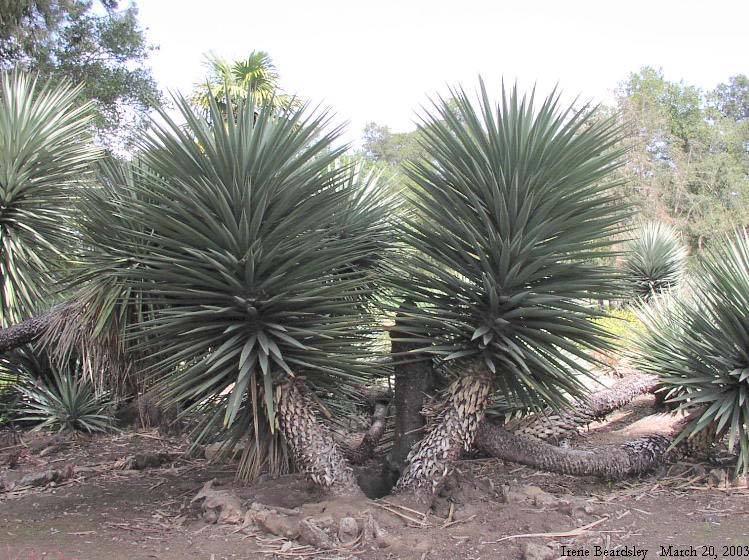Yucca schottii
 mountain yucca
mountain yucca
Arizona
This beautiful plant is the most common yucca in the Arizona Garden. Its key field characteristics are consistent with the description in Irish (2000). The rigid leaves lack filaments on the leaf margins, easily distinguishing it from Y. schidigera. Irish’s treatment describes accurately the habit and leaves seen in the campus population:
Medium-sized species 6–20 ft tall, often with a single trunk that has a few simple branches. The dark brown trunk is usually 8–12 inches wide [and much wider on the largest individual in the Arizona Garden, which has fallen over] and may be clear of dead leaves. The leaves are blue-green to gray-green in color, smooth to the touch, and slightly shiny. They are 1.5–3 ft l. and 1–2.5 in. wide and usually are straight and rigid but can be slightly curved. [campus individuals show both straight and curved leaves.] They are concave in cross section and are lined with an attractive light-brown stripe. They end in a sharp light brown terminal spine. (Irish, p. 270)
McKelvey (1938) wrote, regarding Y. schottii, quoting Sargent:
This is probably the least known of all our Yuccas in cultivation. There are a few noble specimens, however, in the gardens of Tucson, Arizona, and seeds have been distributed last year from the Arnold Arboreteum." It grew in the Arboretum of Stanford University as specimens collected by Dudley in 1897 and 1899 testify.
Name derivation: Yucca – Haitian: yuca, or manihot, because young inflorescences sometimes roasted for food; schottii – after Arthur Carl VictorSc hott (1814–1875), one of the naturalists of the Mexican Boundary Survey.
Related material:
- Engelmann. 1873. Acad. Sci. St. Louis Trans 3: 46.
- McKelvey, Susan. 1938. Yuccas of the Southwestern United States. Jamaica Plain: Arnold Arboretum, 1938. pp. 82+
- Shreve, Forrest and Ira Wiggins. 1951. Vegetation and Flora of the Sonoran Desert. Stanford, CA: Stanford University Press. Vol. 1. pp. 351+
- Webber, John. 1953. Yuccas of the Southwest. USDA. pp. 20+.
- Irish, Mary. 2000. Agaves, yuccas, and related plants: a gardener’s guide. Portland, Or.: Timber Press.
- Lenz, L. W. and M. A. Hanson. 2000. Typification and change in status of Yucca schottii (Agavaceae). Aliso 19:93–98. Comment from Flora of North America: “Yucca madrensis is closely related to Y. jaliscensis to the south and the Y. schottii complex to the north. We follow L. W. Lenz and M. A. Hanson (2000), who have determined that plants with long, wide, flexible, blue leaves that are now usually identified as Y. schottii Engelmann (not congruent with Engelmann’s original description) are more correctly referred to Y. madrensis. Lenz and Hanson further suggested that what is now called Y. schottii represents a hybrid complex among Y. baccata, Y. elata, and Y. madrensis. This putative hybridization is conjectural, and without firm evidence we are uncertain as to the appropriate disposition of the name Y. schottii. We are somewhat skeptical of the potential for crosses between baccate species (Y. baccata and Y. madrensis) and capsular species (Y. elata).”
About this Entry: John Rawlings authored/updated the text ca. 2005–2013.




